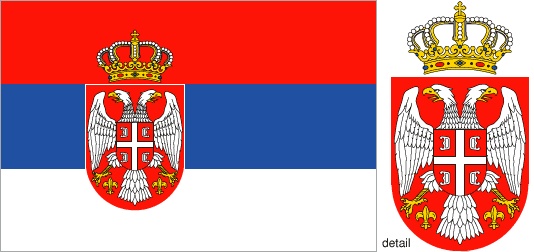Serbia, flag of
Flag History

national flag containing three equal red, blue, and white horizontal stripes and, near the hoist, the Serbian coat of arms. Its width-to-length ratio is 2 to 3.
The design of the Serbian flag dates to Serbia's revolt against Ottoman rule in 1804, when it adopted the white-blue-red tricolour flag of Russia (Russia, flag of) but with the order of the stripes rearranged. Eventually these became known as the pan-Slavic (Slav) colours, and they were used by many other Slavic countries in Europe, particularly during the revolutionary movements of 1848. The Ottoman sultan officially recognized the Serbian flag in 1835 and also in 1869; the country became independent in 1878. In 1882 Serbia established a state flag consisting of the red-blue-white tricolour with the royal Serbian coat of arms. The arms showed a red shield bearing a white cross with a Cyrillic C in each corner—the letters popularly thought to mean, “Samo sloga Srbina spasava” (“Only unity will save the Serbs”). The shield also bore historic dynastic symbols: a white double-headed crowned eagle and a fleur-de-lis next to each talon.
Following World War I, Serbia, as part of the Kingdom of Serbs, Croats, and Slovenes (later renamed Yugoslavia), had no flag of its own but flew the Yugoslav blue-white-red tricolour (first hoisted on Oct. 31, 1918, shortly before the establishment of the kingdom). The country was dissolved during World War II but was reestablished as a federation in 1945; a yellow-bordered red star was added to the centre of the former Yugoslav flag. The country's constituent republics were also allowed flags of their own, and Serbia adopted the Serbian red-blue-white tricolour, bearing a yellow-bordered red star in the centre, in 1947.
 In 1991–92 the country broke up into new independent states, leaving only Montenegro and Serbia as parts of Yugoslavia. The Yugoslav tricolour, minus the star, was adopted as the national flag in April 1992. In 2003 the country changed its name to Serbia and Montenegro; a new flag was anticipated but never created. However, a new Serbian flag was adopted on Aug. 17, 2004, featuring the traditional red-blue-white stripes with the Serbian royal arms near the hoist; the civil flag had the three stripes only. After Montenegro seceded from the federation on June 3, 2006, Serbia proclaimed its independence on June 6, adopting the 2004 design for its national flags.
In 1991–92 the country broke up into new independent states, leaving only Montenegro and Serbia as parts of Yugoslavia. The Yugoslav tricolour, minus the star, was adopted as the national flag in April 1992. In 2003 the country changed its name to Serbia and Montenegro; a new flag was anticipated but never created. However, a new Serbian flag was adopted on Aug. 17, 2004, featuring the traditional red-blue-white stripes with the Serbian royal arms near the hoist; the civil flag had the three stripes only. After Montenegro seceded from the federation on June 3, 2006, Serbia proclaimed its independence on June 6, adopting the 2004 design for its national flags.- George Rogers Clark
- George Romney
- George, Saint
- George Saintsbury
- George Sand
- George Sandys
- George Sanger
- George Santayana
- Georges Arnaud
- Georges Auric
- George Savile, 1st marquess of Halifax
- George Savile Halifax, 1st marquess of
- Georges, Baron Cuvier
- Georges Bataille
- Georges Bernanos
- Georges Bidault
- Georges Bizet
- Georges Blondel
- Georges Boulanger
- Georges Braque
- Georges Carpentier
- Georges Catroux
- Georges Charpak
- Georges Chastellain
- Georges Claude